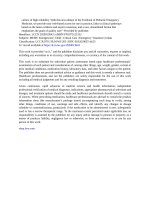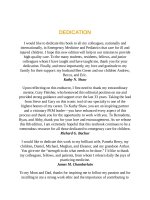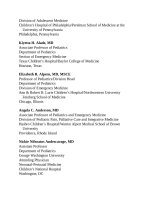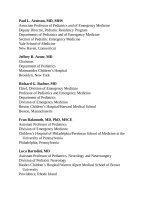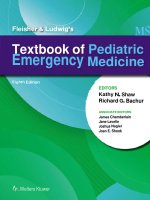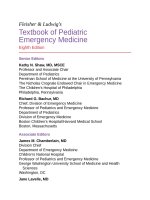Pediatric emergency medicine trisk 808
Bạn đang xem bản rút gọn của tài liệu. Xem và tải ngay bản đầy đủ của tài liệu tại đây (83.79 KB, 4 trang )
for a detailed examination of the size and depth of the wound. A burn
dressing should be placed immediately after wound assessment.
Management
Blisters. For minor burns, blisters provide a biologic dressing and intact
blisters should not be ruptured, unless they are large, crossing joints or
limiting activity, or those obscuring the assessment of the degree of overall
injury. Once the blister has ruptured spontaneously, it will likely need
debridement to improve healing and prevent infection. For these less
extensive debridements, a single dose of intranasal or intramuscular opioids
can be effective and avoid the need for placement of an intravenous
catheter. Ruptured blisters should be unroofed using gauze and sterile saline
to remove devitalized tissue, and antimicrobial ointment should be placed
on the exposed wound surface.
Dressings. A superficial burn does not require dressing, and pain control
with ibuprofen or acetaminophen can be given as needed. Following
cleaning, a topical dressing is applied directly to the wound surface. We
recommend bacitracin for the face, head, and perineum as well as the
fingers and toes if there is a risk of ingestion, Polysporin Ophthalmic for
periorbital burns, and silver sulfadiazine (Silvadine) or triple antibiotic
ointment for all other burns. Of note, Silvadine cannot be used in patients
with a sulfa allergy. Silver-impregnated dressings have also shown
promising results. Work to identify the best dressing to encourage healing
and reduce infection risk is ongoing, and practice may vary based on
provider or institutional preference. Following the selected topical
treatment, a nonadherent dressing is placed on the burn, which can then be
wrapped with gauze.
Dressings should be changed twice each day. The parent should rinse off
residual antibacterial ointment with warm water and inspect the wound.
Signs of infection, such as redness and tenderness around the margin of the
burn, warrant immediate evaluation by a physician. A gray-greenish
material formed by serous drainage from the burn mixing with the silver
sulfadiazine cream is often mistaken for purulence. If the burn is healing
well, the parent should reapply the antibiotic ointment and dress the wound
as demonstrated by the physician or nurse in the ED. Burns should be
examined by a physician every 2 or 3 days until healing is well underway.
Large burns or burns of the hands, feet, perineum, or overlying joints that
are managed as an outpatient should be referred to a burn specialist and
evaluated in follow-up more frequently. Prophylactic antibiotics are not
recommended.
Minor partial-thickness burns can be expected to have epithelial healing
in 7 to 14 days.
SPECIAL CIRCUMSTANCES
Goals of Treatment
Certain types of burns require special attention. Clinicians should remain
alert to historical and/or physical examination findings which suggest
inflicted burn injuries, electrical injuries, and/or chemical burns. Each of
these burns warrants additional workup and specific treatment.
Inflicted Burns
Child abuse must be considered in patients with specific patterns of burn
injury. Between 10% and 20% of burns in children are inflicted, accounting
for 10% of child abuse cases. Most inflicted burns are scalds. Forced
submersion of the hands or feet often causes burns that are deep, have a
clear line of immersion, and are symmetric. Scald burns of the buttocks and
thighs in toddlers are frequently the result of forcible submersion in a tub of
hot water. Scald burns usually have scattered splash lesions. In burns from
spilled hot beverages, there is often a pattern of injury spreading downward
from the falling liquid. Inflicted contact burns also have characteristic
patterns. Small, round, deep burns result from cigarettes intentionally
applied to the skin. A deep wound with a geometric pattern and sharply
demarcated borders suggests a contact burn. Deep injuries with distinctive
patterns may also be noted in children held against portable heaters or
burned with irons.
In many children with inflicted burns, the pattern of injury is nonspecific
and a history of abuse is not offered. Physicians should make a judgment
whether the characteristics of a burn correspond with the reported
mechanism in a plausible way. Identifying suspicious injuries and
consulting with child abuse specialists can prevent subsequent injuries.
Electrical Burns
Burns that result when electrical current passes through the body have
unique characteristics. Each year, there are more than 4,000 ED visits
caused by electrical injuries, mostly in children. Electrical burns account for
3% of burn center admissions and are increasing in number. Most injuries
occur in young children from contact with low-voltage (less than 120 V)
alternating household current, often from mouthing plugs or extension
cords. Severe high-voltage (more than 500 V) injuries are also seen, often
in adolescent boys as a consequence of risk-taking behaviors.
Thermal energy is released in proportion to the amount and duration of
electrical current that passes through tissue. Current flows preferentially
through tissues of low electrical resistance, such as blood vessels, nerves,
and muscles. Moisture on the skin decreases resistance, accounting for the
greater severity of electrical burn injury in the antecubital, axillary,
popliteal, and inguinal areas. Current arcing through the skin can ignite
clothing and cause severe thermal burns in addition to the electrical injury.
In some direct current electrical burns, a depressed entrance wound and a
blown out exit wound can be identified. If the current traverses the heart,
which occurs more often when the flow is arm to arm, a myocardial injury
may occur. Current through the heart at certain points of the cardiac cycle
can induce ventricular fibrillation or asystole. Electrical injury, especially
by alternating current, can cause tetany of the musculature that may prolong
the contact with the high-voltage source. Tetany of the respiratory muscles
can lead to suffocation.
The initial approach to patients of electrical burns is similar to that in
other children with severe burns. Electrical burns are usually more severe
than they appear. Significant deep and internal injuries may occur in
patients with relatively small external burns. Fluid requirements are higher
than those predicted by formulas based on percentage of BSA because a
larger portion of the injury is internal. Destruction of muscle often causes
myoglobinuria, so serum creatine kinase and urine for myoglobin should be
tested. Renal failure can usually be prevented with forced diuresis and
alkalinization. Electrical injury and edema within fascial compartments can
cause a compartment syndrome requiring fasciotomy. Patients with a
normal electrocardiogram (rate and rhythm) in the ED do not appear to be
at significant risk for later development of arrhythmias. Severe electrical
injuries require extensive evaluation for internal injuries, which should be
done at a pediatric tertiary care or regional burn center.
A common electrical injury occurs to the lips and mouth of toddlers who
suck on plugs or extension cords. Deep burns at the corner of the mouth
require specialized attention to prevent severe scarring and contracture (see
Chapter 105 Dental Trauma ). Bleeding from the labial artery 1 to 2 weeks
after injury, when the eschar separates, can result in significant blood loss.
In previous years, children with electrical injuries were hospitalized for 2
weeks, but most burn specialists now manage these children as outpatients
after giving careful instructions to caregivers.
Chemical Burns
More than 25,000 different caustic products are in use in the United States.
Most are either acidic or alkaline. Acids cause coagulation of tissue
proteins, which limit the depth of penetration. Alkali results in liquefaction
and deeper injury. Some organic compounds, including petroleum products,
damage tissue by dissolving the fats in cell membranes. Caustic chemicals
on the skin cause a prolonged period of burning compared with most
thermal burns. The patient may arrive in the ED with the chemical still
present, and so careful attention to decontamination and avoiding staff
exposure is crucial.
The chemical exposure should be removed as quickly as possible, most
often using irrigation. Close consultation with a toxicologist or poison
control center is recommended as water irrigation can worsen some
chemical burns, and specific antidotes are indicated for specific exposures
(see Chapter 102 Toxicologic Emergencies for further details).
Edema of the underlying tissue can make full-thickness injuries appear
deceptively superficial. A thorough examination is necessary to identify
other areas of skin exposed from splashes or contact that also require
irrigation. Chemical burns to the eye can threaten vision and, after starting
irrigation, require prompt consultation with an ophthalmologist.
Consultation with a burn specialist and admission are recommended at
smaller percentages of BSA with chemical burns than with thermal injuries.
